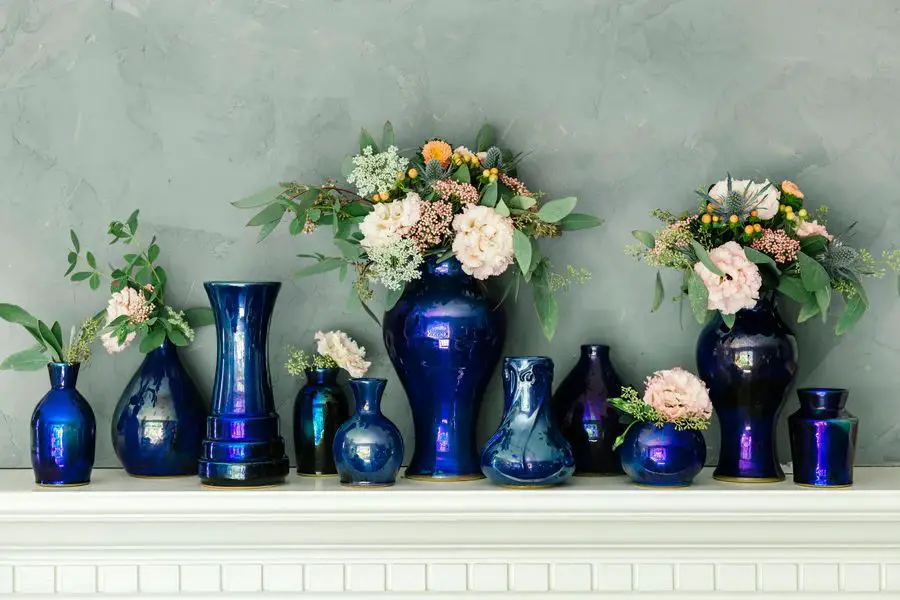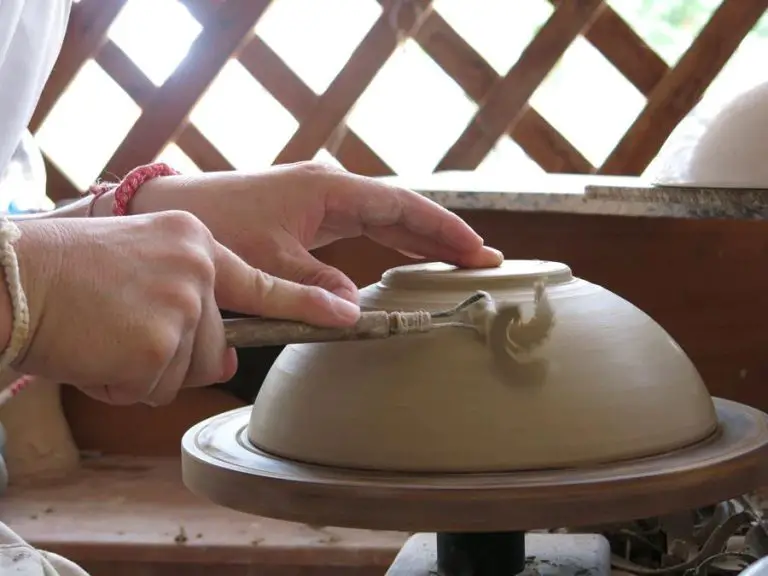How Do I Identify Pewabic Pottery?
History of Pewabic Pottery
Pewabic Pottery has a rich history as one of the oldest continually operating ceramic studios in the United States. It was founded in 1903 by Mary Chase Perry Stratton and Horace James Caulkins in Detroit, Michigan. Located originally in a rented stable, Pewabic was started as a way for Perry Stratton to create beautiful ceramic works and promote the Arts and Crafts movement in Detroit.
Mary Chase Perry Stratton was the driving creative force behind Pewabic and served as president until her death in 1961. She experimented with iridescent glazes and developed the unique Pewabic style, drawing inspiration from European, Islamic, and Asian ceramic traditions. Under her leadership, Pewabic grew from a small studio to an incorporated business selling tiles, vessels, and architectural pottery nationwide.
Over its 120+ year history, Pewabic Pottery has evolved from a small Detroit studio to an American icon of art pottery. It continues to operate today out of an historic English Tudor-style building, producing handcrafted ceramic tiles and vessels. Pewabic’s unique glazes and designs stand as a testament to Perry Stratton’s artistic legacy.
Styles and Techniques
Pewabic is known for its distinctive glazes which give the pottery its signature look. The most iconic is the iridescent glaze which has a lustrous, opalescent sheen. As the lighting shifts, the colors seem to change and glow, from deep blues and greens to fiery coppers and golds. This innovative glaze was developed by Mary Chase Perry Stratton, Pewabic’s founder and the driving creative force.
Pewabic also utilizes special matte finishes which have a more muted, velvety look. These include a rich mahogany red matte and a warm tan matte.
In terms of pieces, Pewabic is famous for its handcrafted tiles used in architectural installations. In its early years, it created custom tile installations for notable buildings like the Michigan State Capitol and Rockefeller Chapel. Today, clients commission custom tiles for new installations as well as restoration projects.
In addition to tiles, Pewabic produces a variety of pottery vessels. These include vases, jars, bowls, mugs, and plates. The pottery vessels showcase both the signature iridescent glazes as well as the matte finishes.
Pewabic artists also make functional ware like sinks, fountains, and lighting. The tradition of metalwork paired with the ceramic tiles or vessels creates striking original pieces.
For citations, refer to: Pewabic Tile
Common Design Motifs

Pewabic Pottery is known for incorporating several classic design motifs into their ceramic art pieces over the decades.
Some of the most recognizable motifs are nature-inspired designs featuring flowers, trees, animals and more. Bold
representations of flowers like irises, roses, tulips, and sunflowers are prevalent, along with trees like maples and oaks.
Birds, butterflies, fish, and other animals also make frequent appearances.
Geometric patterns using lines, circles, triangles, squares, and other shapes are also hallmarks of Pewabic’s aesthetic.
These visual elements are combined in graphic, abstract designs across many works.
Finally, architectural influences emerge through the inclusion of buildings, facades, windows, archways, and other
structural references. Key examples are Pewabic’s tilework featuring notable Detroit landmarks like the Guardian Building,
Fisher Building, and Michigan Central Station (1).
Marks and Signatures
Pewabic Pottery pieces can be identified by various marks and signatures. The earliest pieces made from 1903-1907 were unmarked. In 1907, the first Pewabic logo was introduced, consisting of five maple leaves arranged in an arc beneath the word “PEWABIC” impressed into the clay.
Other early marks include Mary Chase Perry Stratton’s intertwined monogram impressed into the clay, first used in 1909. Her monogram features an “M”, “C”, and “P” for Mary Chase Perry. Another variant of Stratton’s monogram is a handwritten “MPS” in slip or glaze.
From 1907-1967, pieces were marked with an impressed Pewabic logo featuring the word “Pewabic” above a circle with five maple leaves inside. Variations exist with “Detroit” added below the circle. According to Pewabic Pottery: Marks and Labels, this logo is one of the most common on Pewabic wares.
Other distinguishing marks seen on Pewabic pieces include dates, the words “Made in Detroit”, paper labels, and inventory numbers. Marks may be impressed into the clay, incised, or hand painted with slip or glaze. Experts can help authenticate markings to identify genuine Pewabic Pottery.
Popular Product Lines
Pewabic has a variety of popular product lines that collectors seek out. Some of the most well-known include:
Mettlach tiles – These decorative ceramic tiles were first produced in 1891 and feature detailed imagery like fish, flowers, and geometric patterns. The art nouveau-style tiles were made at Pewabic’s associate pottery in Mettlach, Germany and imported to the US.[1]
Vellum shapes – Introduced in 1979, these nature-inspired pieces feature delicate, translucent appearances. Items like leaf-shaped bowls and acorn-shaped jars are made using a challenging process that results in an ultra thin, lightweight ceramic.[2]
Garden pottery – From planters to birdbaths, Pewabic’s outdoor ceramics allow collectors to bring the beauty of their glazes into the landscape. The sustainable, weather-resistant garden pieces come in a variety of forms like cylinders, bowls, and pedestals.
How to Date Pieces
Dating Pewabic pottery can be challenging, but there are some clues in the marks, logos, glazes, and styles that can help determine the era a piece was produced.
One of the main ways to date Pewabic pottery is by looking at the mark or logo. Earlier pieces from 1903-1932 were marked with “Pewabic Pottery” in block letters. From 1932-1979, the logo changed to an impressed circle or oval with “Pewabic” in the center. After 1979, the logo changed again to say “Pewabic Pottery” in a font around the top edge of a circle or oval (Pewabic Pottery: Marks and Labels).
The glazes and styles also evolved over Pewabic’s history. Earlier pieces from 1903-1920s often had an iridescent glossy glaze. From the 1920s-1950s, matte glazes became popular and earth tone colors were frequently used. In the 1970s-1990s, brighter colors and bolder designs became common (Events).
Some tips for identifying era from style: Pieces with Art Nouveau designs tend to be earlier, while Mid-Century Modern and geometric motifs likely date to the 1950s-1970s. Items with a brushed matte finish often come from the 1920s-1950s. Brightly colored glossy glazes point to the 1970s or later.
Where to Find Authentic Pieces
Some of the best places to find authentic Pewabic pottery include:
The Pewabic store and studio in Detroit, Michigan. This store sells newly made pieces directly from Pewabic’s studio. Visiting the store allows you to see potters at work and buy directly from the source.
Auctions, antique stores, and estate sales, especially in Michigan. Pewabic pieces may turn up alongside other art pottery from the Arts and Crafts movement. Reputable sellers will provide authentication details.
Museum gift shops, university collections, or other institutions. Places like the Detroit Institute of Arts sell authenticated Pewabic pieces. University collections may also sell duplicates to support their programs.
Authentication Methods
To verify that a piece of pottery is truly an authentic Pewabic artifact, there are a few key authentication methods experts recommend:
First, carefully examine the piece for distinguishing marks, signatures, or logos that can help identify it as Pewabic. According to the Pewabic Archives, pieces made before 1903 will be unsigned, while those made after 1903 often have markings like impressions of the words “Pewabic Pottery” or “Made in Pewabic.” The clay body can also help date the piece.
It’s also wise to have the piece appraised by an expert who specializes in Pewabic pottery. An appraiser can examine factors like glazes, color patterns, mold seams, and bottom markings to determine authenticity.
Checking the provenance or origin story of the artifact can also help verify it’s real. Having documentation of previous owners, receipts, or other records tracking the piece back to its origins at Pewabic can authenticate it.
Using a combination of these methods – inspecting details, consulting an appraiser, and verifying provenance – is the best way to ensure a piece of pottery is an authentic Pewabic product.
Maintenance and Care
Taking proper care of your Pewabic pottery pieces ensures that they continue to stand the test of time while retaining their beauty and value. Here are some tips for maintaining and caring for your prized Pewabic pottery:
Use gentle cleaning methods. Avoid abrasive cleaners or scrubbing as this can damage the glazed surface. Instead, wash pieces by hand with warm water and mild dish soap. Rinse thoroughly. You can also dust pieces with a soft, dry cloth.
Handle pieces carefully, supporting them from the bottom. Don’t pick up pots by handles or spouts, which can lead to cracks or breaks. Also avoid banging pieces together while washing or storing.
To prevent fading, avoid prolonged exposure to direct sunlight which can cause colors to dull over time. Display pieces out of direct light.
Prevent chips and cracks by providing adequate support with non-slip padding on shelves and in cabinets. Stack pieces gently with cushioning in between. For added protection, store fragile or valuable items in storage boxes.
While beautiful, Pewabic pottery is delicate and requires reasonable care. By handling with care and cleaning gently, your Pewabic pieces can provide enjoyment for generations.
Value and Collectibility
The value of Pewabic Pottery pieces can vary substantially based on age, condition, and rarity. Some of the most coveted and expensive Pewabic pieces date back to the early years of the pottery’s founding in 1903. Pieces designed and produced by founders Mary Chase Perry and Horace Caulkins, and early artisans like Charles Murphy, are highly prized by collectors and can sell for thousands of dollars at auction.
Rarer glaze techniques like iridescent lusters and experimental finishes also command premium pricing. Signed pieces in pristine condition fetch higher prices than unsigned pieces or those with any damage or restoration. According to LiveAuctioneers, rare Pewabic vases have sold for over $14,000 at recent auctions.
Currently, the Pewabic collectors market remains strong for vintage pieces from the early 20th century, as well as innovative designs from the 1960s and 1970s. While prices have softened a bit from peak levels in the 2000s, interest in American art pottery remains high among collectors. As one of the premier American ceramic studios, Pewabic Pottery continues to have an enthusiastic base of collectors seeking museum-quality pieces.



